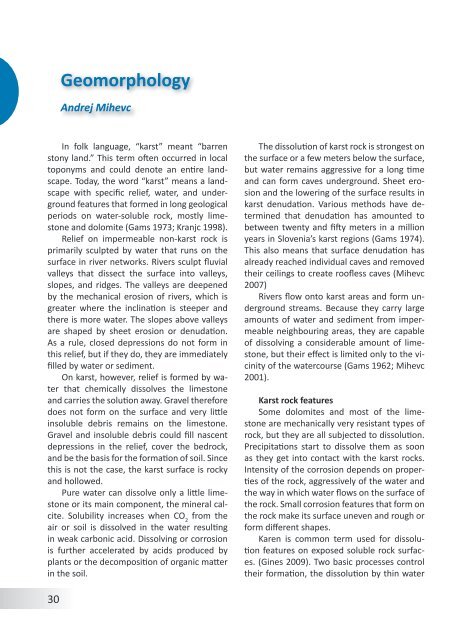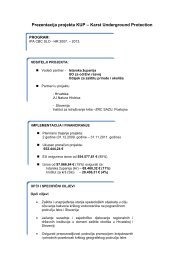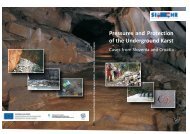Case Studies from the Dinaric Karst of Slovenia
Case Studies from the Dinaric Karst of Slovenia
Case Studies from the Dinaric Karst of Slovenia
You also want an ePaper? Increase the reach of your titles
YUMPU automatically turns print PDFs into web optimized ePapers that Google loves.
GeomorphologyAndrej MihevcIn folk language, “karst” meant “barrenstony land.” This term <strong>of</strong>ten occurred in localtoponyms and could denote an entire landscape.Today, <strong>the</strong> word “karst” means a landscapewith specific relief, water, and undergroundfeatures that formed in long geologicalperiods on water-soluble rock, mostly limestoneand dolomite (Gams 1973; Kranjc 1998).Relief on impermeable non-karst rock isprimarily sculpted by water that runs on <strong>the</strong>surface in river networks. Rivers sculpt fluvialvalleys that dissect <strong>the</strong> surface into valleys,slopes, and ridges. The valleys are deepenedby <strong>the</strong> mechanical erosion <strong>of</strong> rivers, which isgreater where <strong>the</strong> inclination is steeper and<strong>the</strong>re is more water. The slopes above valleysare shaped by sheet erosion or denudation.As a rule, closed depressions do not form inthis relief, but if <strong>the</strong>y do, <strong>the</strong>y are immediatelyfilled by water or sediment.On karst, however, relief is formed by waterthat chemically dissolves <strong>the</strong> limestoneand carries <strong>the</strong> solution away. Gravel <strong>the</strong>reforedoes not form on <strong>the</strong> surface and very littleinsoluble debris remains on <strong>the</strong> limestone.Gravel and insoluble debris could fill nascentdepressions in <strong>the</strong> relief, cover <strong>the</strong> bedrock,and be <strong>the</strong> basis for <strong>the</strong> formation <strong>of</strong> soil. Sincethis is not <strong>the</strong> case, <strong>the</strong> karst surface is rockyand hollowed.Pure water can dissolve only a little limestoneor its main component, <strong>the</strong> mineral calcite.Solubility increases when CO 2<strong>from</strong> <strong>the</strong>air or soil is dissolved in <strong>the</strong> water resultingin weak carbonic acid. Dissolving or corrosionis fur<strong>the</strong>r accelerated by acids produced byplants or <strong>the</strong> decomposition <strong>of</strong> organic matterin <strong>the</strong> soil.The dissolution <strong>of</strong> karst rock is strongest on<strong>the</strong> surface or a few meters below <strong>the</strong> surface,but water remains aggressive for a long timeand can form caves underground. Sheet erosionand <strong>the</strong> lowering <strong>of</strong> <strong>the</strong> surface results inkarst denudation. Various methods have determinedthat denudation has amounted tobetween twenty and fifty meters in a millionyears in <strong>Slovenia</strong>’s karst regions (Gams 1974).This also means that surface denudation hasalready reached individual caves and removed<strong>the</strong>ir ceilings to create ro<strong>of</strong>less caves (Mihevc2007)Rivers flow onto karst areas and form undergroundstreams. Because <strong>the</strong>y carry largeamounts <strong>of</strong> water and sediment <strong>from</strong> impermeableneighbouring areas, <strong>the</strong>y are capable<strong>of</strong> dissolving a considerable amount <strong>of</strong> limestone,but <strong>the</strong>ir effect is limited only to <strong>the</strong> vicinity<strong>of</strong> <strong>the</strong> watercourse (Gams 1962; Mihevc2001).<strong>Karst</strong> rock featuresSome dolomites and most <strong>of</strong> <strong>the</strong> limestoneare mechanically very resistant types <strong>of</strong>rock, but <strong>the</strong>y are all subjected to dissolution.Precipitations start to dissolve <strong>the</strong>m as soonas <strong>the</strong>y get into contact with <strong>the</strong> karst rocks.Intensity <strong>of</strong> <strong>the</strong> corrosion depends on properties<strong>of</strong> <strong>the</strong> rock, aggressively <strong>of</strong> <strong>the</strong> water and<strong>the</strong> way in which water flows on <strong>the</strong> surface <strong>of</strong><strong>the</strong> rock. Small corrosion features that form on<strong>the</strong> rock make its surface uneven and rough orform different shapes.Karen is common term used for dissolutionfeatures on exposed soluble rock surfaces.(Gines 2009). Two basic processes control<strong>the</strong>ir formation, <strong>the</strong> dissolution by thin water30










